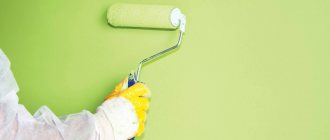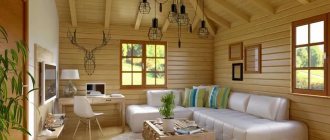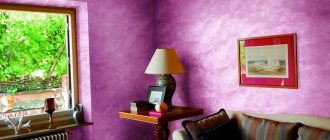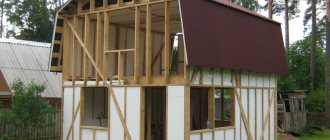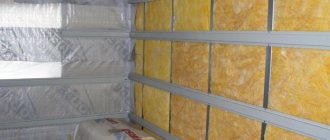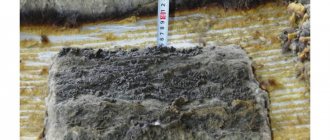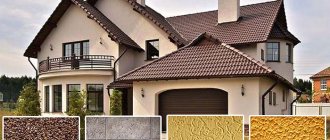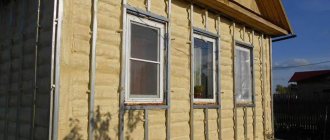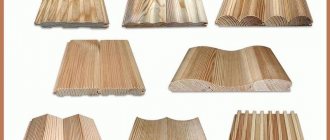Wood has remained a popular type of construction material for many centuries; it is a natural and environmentally friendly material. Due to these properties and the pleasant appearance of wood, it is also used for interior decoration of walls in various buildings. Wooden surfaces are known to be susceptible to water damage, and a variety of products must be applied to them to prolong their service life. This includes dyeing. How to paint wooden walls inside a house will be discussed below.
Why do you need to paint the inside of your house?
A wooden house is warm in winter and not hot in summer, because wood can breathe, creating a healthy microclimate in the house. But, if there is high humidity in the room, then mold, mildew, and pathogenic microorganisms can form in the wood, causing the wood to rot.
Wood is negatively affected by temperature changes, which can cause it to deform or crack. Sometimes in a log house you can see passages, small holes - this is wood eaten away by beetles. To prevent the house from being destroyed from the inside, protective solutions are used that will not only renew the appearance of the tree, but also protect it from destruction. And the best way to do this is paint.
What color to paint the outside of a wooden house: photos of fashionable solutions
Depending on what product you use to paint a wooden facade, it is possible to completely change the color or emphasize the natural colors of the wood.
Materials for surface preparation and coloring of wood for interior decoration
In order for the paint for the interior decoration of a wooden house to lay down evenly, you need to properly prepare the surface. To prepare for painting, antiseptics, fire retardants, bio-moisture protective solutions, primers, and bleaching agents are used.
Antiseptics and fire retardants for preparing wood for painting
Antiseptic solutions are needed to protect wood from the appearance of fungus and mold on its surface and inside, and to destroy harmful microorganisms.
Antiseptics include coatings and impregnations. Impregnations penetrate deep into the wood fibers. But, before use, you need to check the composition, as they can be toxic and should not be used indoors.
Coating materials are applied to the surface of wooden walls to protect against water. Such substances are intended for interior decoration of rooms with high humidity.
Antiseptic compositions are also divided into:
- water soluble. These are environmentally friendly, harmless products. But over time, their protective properties decrease. They are used before painting surfaces with water-dispersion paints;
- organic. Their protective indicators are high. But they are toxic, have a strong odor and are a fire hazard when dry. Therefore, they are not used for interior work, but only for painting facades;
- oil antiseptics - used for outdoor work due to their persistent odor and long drying time;
- combined antiseptic solutions are effective not only for external, but also for internal work. High-carbon and oil components of the composition provide high-quality protection against mold and rot. They are easily used in rooms with high humidity.
Each composition has its own brush with natural or artificial bristles.
The most popular are bio-moisture-protective antiseptics. They create a protective barrier from harmful influences, do not wash out, and give the wood an aesthetic appearance.
Fire retardants are products that protect wood from rapid fire. In the event of a fire, the walls of the house will not catch fire, but will begin to slowly smolder.
Fire retardants come in two types. Some contain salts that, when exposed to high temperatures, release gases that prevent combustion. The second type of fire retardants creates a protective coating on the surface in the form of foam.
Compositions that combine the qualities of antiseptics and fire retardants are called biopyrenes.
Primer solutions promote better adhesion of paint to the surface.
Varnishes as a protective and decorative agent
They are needed to renew the wooden covering and to protect it from harmful influences.
Varnishes are divided into:
- acrylic. They are environmentally friendly, non-toxic, have no pungent odors, but wear out quickly. Used to cover interior walls and furniture;
- polyurethane. They are water-based, so they do not emit harmful substances, and they have almost no odor. Such varnishes have high strength properties and do not wear out for a long time. Used to cover walls and floors indoors;
- alcohol They are made of natural resins, have high strength, but allow moisture to pass through, so it is not recommended to use them in a bathhouse or bathroom;
- nitrocellulose - consist of synthetic resins, solvents and cellulose nitrate. Some nitro varnishes are used only to prepare surfaces before painting. Other nitrocellulose varnishes are needed to create a durable finish. They are transparent, only highlighting the special grain of the wood. But these products are flammable in their uncured form and smell unpleasant;
- oil varnishes - form a durable protective glossy layer of a warm ocher shade on the surface. Used for finishing walls and furniture;
- alkyd - similar to oil ones, but have more durable performance characteristics. Used for finishing inside and outside.
Paints for finishing wooden walls
Dark coloring of a room visually reduces its size.
Paints for interior work should not be toxic, have a pungent odor, or harm human health. To find out how to paint timber inside a house and whether the characteristics of the products meet the main safety requirement, you need to familiarize yourself with its components. You can look at the coloring composition on the packaging or ask your sales consultant about it.
Hand painted
For many, updating the façade is an opportunity to show their individuality. The exterior does not have to be boring and restrained. If your soul requires color, brightness and experimentation, it’s time to take up your brushes. As a source of inspiration you can use:
- National painting;
- Geometric and floral patterns;
- Abstract impressionist paintings, etc.
Choosing paint based on purpose
There are several types of paint for interior work. They differ in composition, drying time and price.
The colors are:
- water based. They are not resistant to moisture and are easily washed off with water;
- organic. They are based on a solvent. Such paints are moisture resistant, have a high level of hiding power, and have a long service life. But they are not always used for interior painting, because they contain solvents and other fast-drying substances. They have a strong odor, are flammable and emit toxic components that are harmful to the health of people and pets.
Acrylic
Acrylic paints reliably protect walls from harmful influences and are durable. Provide high adhesion to surfaces, prevent cracking and deformation during shrinkage.
Alkyd and enamels
These paints give a glossy surface effect. They dry quickly due to the solvent they contain, but they smell unpleasant.
It is better to work with them in a respirator, because among different alkyd enamels there are products that release toxic substances.
The surface painted with enamel is durable, can be easily washed, and is not afraid of aggressive detergents. But, over time, the enamel turns yellow and fades from direct sunlight.
Water-dispersed
Water-based paints contain a lot of water, so it is not recommended to paint glossy and metal objects with them. Water-based paint is considered an environmentally friendly and safe paint because it does not emit toxic substances. It consists of an aqueous suspension, polymers and fillers. Due to polymers, the water base evaporates during application, leaving a thin film on the surface. When painting with a brush or roller, no streaks remain.
Water-dispersion paints can be used to mask any darkened stain. They dry quickly and can be diluted with water to give the walls the desired shade. The protective layer of water-dispersion paints is less durable than that of varnishes and has low wear resistance.
Silicone
Silicone paints are a reliable coating. They are not prone to abrasion, do not allow moisture to pass through, and do not fade from exposure to ultraviolet rays.
The paint is made on the basis of silicone resins, and high vapor permeability preserves the wood’s ability to breathe. The product is elastic, so it can easily veil cracks up to 2mm thick. Long service life.
Oily
Oil paints are an organic type, created on the basis of drying oil. Since they take a long time to dry and have a sharp, unpleasant odor, they are rarely used for interior decoration and only in the warm season.
To dilute oil paints, use gasoline and white spirit. The paints apply easily, creating a durable opaque layer, but it is opaque, and the wood pattern is not visible through it. The shiny shade gives the surface painted with this product an excellent appearance and smoothes out any unevenness and defects in the wall surface. They can be wiped with a damp cloth and cleaned with detergents. The color of the painted surface will not change, will not fade, or be damaged.
Due to the fact that the paint composition releases harmful substances during the work process, when drying, it is used mainly for outdoor work. But important qualities: high strength and moisture resistance allow you to paint rooms inside the house with it. For example, for the bathroom and kitchen - rooms with high humidity.
Dollhouse effect
If you want to add a little magic and spontaneity to the exterior, choose pink, soft blue or purple paint. White frames, platbands, support pillars, and railings will add even more doll-like quality.
Carved roof decorations and patterned balusters on the porch will add lightness. The updates will definitely appeal to its little inhabitants, and sometimes it’s useful for adults to be transported back to childhood.
Color selection, recommendations
To choose the right paint color, you need to take into account the style of the interior - the color of the walls should be combined with the design and style of the room. If you want to decorate the inside of your house in a classic style, then painting should be done with transparent compounds to highlight the beauty and grain of the wood. The Scandinavian style is characterized by pastel and white colors. If you need to visually expand the space, then you should choose light-colored paint, and if you need to narrow it, then dark ones.
Pastel colors look harmonious in the interior of a house made of rounded logs and are combined with modern appliances
Monochrome
Houses with the same color of facade and roof look unusual. The tone may be slightly different, or it may be completely the same. It is better to choose a shade from a palette of dark and deep colors.
Plain facades always harmoniously coexist with the lush greenery of the surrounding landscape. The house becomes a stylish and spectacular accent that attracts the eye.
Required tools and supplies
In order to paint wooden walls from the inside of the house, use the following materials and tools:
- masking tape. It is necessary to protect the surfaces bordering the walls from staining;
- film to cover the floor, doors and furniture;
- sander for preparing walls;
- construction hair dryer and scraper for cleaning old paint;
- brushes, rollers and paint trays;
- sprayer for automatic application of the product;
- protective clothing: rubber gloves, safety glasses, respirator;
- a bucket of water, a rag for wiping away spills.
Stages of painting work
- Purchase of necessary tools, protective clothing and protective equipment, selected paint and varnish coating.
- Preparing a wooden surface for painting: cleaning and sanding.
- Impregnation with moisture protective agents, antibacterial agents and fire retardants.
- Application of primer and decorative painting.
Experienced finishers know that 3-in-1 protective products are less effective for long-term preservation of wood, as is the use of a primer with antiseptic properties. It is recommended to apply each new layer of protective impregnation after the previous product has been absorbed.
Step-by-step instructions for painting a wooden wall indoors
One has only to deviate from the work technology, and the painted surface will spoil the aesthetic appearance of the finish. Let's look at how the interior painting of a wooden house goes: kitchen, children's room, bathroom, living room.
Preparing the surface for painting
Before painting, you need to properly prepare the room:
- First of all, you need to remove the old paint coating. To do this, it is heated with a hair dryer and cleaned off with a scraper or spatula.
- If the inside of the log house has not been painted, but the building material has rotted or darkened, then it is important to remove the damaged wood using a sander.
- You can use an electric plane to deep clean wood. New wood is also sanded smooth.
- Then the wooden walls are coated with antiseptics and fire retardants using a brush or roller. In a log house it is better to use a spray bottle.
Preparing walls for painting is done using petal wheels made of sandpaper with a grain size of 100 -120
Leveling the surface
Before painting, it is important to make the surface smooth, remove defects and knots, so the surface is treated with a grinder. Fine sandpaper will also help smooth out uneven surfaces.
Painting technology
For painting you can use a brush and roller. The roller allows you to cover large areas of the wall and evenly distribute the paint composition over it. Use a brush to go over the joints between logs and corner joints. The paint should be applied in 2-3 layers after the previous one has completely dried.
Professional coloring services
Most property owners tend to save money by not inviting professionals to paint. However, the high-quality result created by specialists will save not only time, but also money. They will tell you which product is best suited for the job and will last longer. You can be sure that the result will be beautiful and durable. The cost of services is often calculated based on the area of the room, calculated by square meters.
However, the high-quality result created by specialists will save not only time, but also money.
Before painting the logs inside the house, the surface should be thoroughly prepared. And also pay special attention to the choice of product. It should not only be beautiful in appearance, but also protect the surface from external factors.
Mistakes when painting yourself
If you decide to paint the walls inside a wooden house with your own hands, then do not make mistakes that can lead to disastrous results:
- lack of preparatory work. Before painting the inside of a log house, it is important to seal all the cracks and level the surfaces. Only on a smooth wall will the paint lie smoothly. In addition, the primer will increase the adhesion of the paint to the wood;
- violation of paint mixing technology. The composition must be diluted exactly according to the instructions recommended by the manufacturer;
- use of low-grade materials. If the paint is inexpensive and of poor quality, then after a while it will peel off, and you will have to renew the coating and spend extra money.
We conclude: in order to paint the walls of a wooden house from the inside efficiently and beautifully, you need to carefully prepare the surface and use good paint.
Landscape camouflage
You can achieve maximum unity with the natural environment by painting your house in the color of the surrounding foliage. In summer, green facades look wonderful, with the onset of autumn - yellow and orange.
For greater harmony, you can add natural stone to the facade decoration, and it is better to leave the tiles as inconspicuous as possible.
